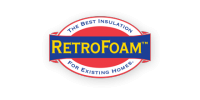The Best Insulation for Existing Homes
The Best Insulation for Existing Homes
RetroFoam is the more expensive option when compared to traditional insulation like fiberglass and cellulose.
That increased cost is because you are going to get better performance from the RetroFoam. There are a few other factors that determine that final cost, so let’s dive in.

The main obvious factor is the size of the area that will be insulated.
Most pricing is going to come down to square footage, but that may not always be the case. It’s important to discuss with your RetroFoam dealer how they determine the final cost of the project so you are both on the same page before the work begins.

There are a few things that come into play when looking at the installation difficulty.
The number of stories a home has, the type of siding, and any prep work to protect indoor and outdoor items are all factors in determining the difficulty. These additional difficulties impact the cost.

Location can also play a role in the cost of your RetroFoam insulation.
Keep in mind that a gallon of milk in New York will be a different price when compared to the same product in California. Those prices are set by the seller in those locations, much like each RetroFoam dealer sets their prices locally.
Besides the potential for lower energy bills, there may be ways to utilize tax credits and rebates to save even more money on your investment in RetroFoam insulation.
Utility companies also offer incentives when homeowners make energy-efficient upgrades to their homes.
Rebates from energy providers vary depending on the utility company, the insulation's performance, and the size of the project. This is something your RetroFoam dealer or utility company can explain further.
When energy-efficient upgrades are made to a home, federal tax credits may be available.
It is always best to talk with your tax professional to see whether any credits are available for your project and to learn about the latest developments.
Utility companies also offer incentives when homeowners make energy-efficient upgrades to their homes.
Rebates from energy providers vary depending on the utility company, the insulation's performance, and the size of the project. This is something your RetroFoam dealer or utility company can explain further.
Jeff Miller was tired of his hard-earned money going to high energy bills each month.
Jeff likes to save money where he can, and when he found RetroFoam insulation, he knew it was a wise investment.
“I would tell anybody to do it,” Jeff Miller said. “It seems pretty pricey to begin with, but just from my own account, I would say between a four- and five-year payback and the rest of your life, you’re making money. Not to mention being comfortable. The difference it made was unbelievable.”
The savings Jeff sees in his monthly heating and cooling bills show it is costing him less to make his home more comfortable than a house half the size.
RetroFoam insulation is a premium insulation material with a higher price tag, but the benefits can make it all worth it.